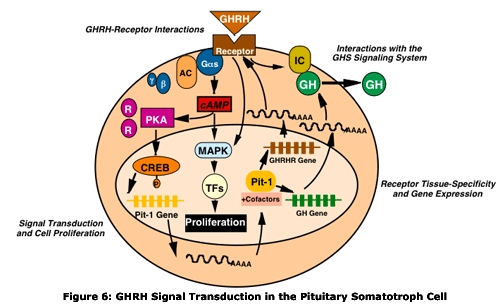(Click here to read our disclaimer)
(Click here to buy gnrh in our store)
GHRH is a molecule that has been discovered in plants, mammals, bacteria, fungi and single cell organisms. Initially, it was discovered in molecular biology in 1958 in human genome studies. Because of the recent identification of this enzyme in other organism’s unrelated to human biology, it is now referred to only by the letters GHRH.
CJC 1295 is the synthetic version of GHRH. CJC 1295 just like GHRH allows certain albumins – a globular protein, which is stored in specific areas of the organisms body – to bind to cell receptors.
The Difference
GHRH and CJC 1295 is the duration length. GHRH is exuded in small spurts for short periods of time over a 24-hour period. CJC 1295 is also released in small bursts but has an extended half-life that continues the bursting action over a longer period during the same 24 hours. CJC 1295 was developed in order to have sufficient lengths of time to measure results, effects and responses that were impossible to do with GHRH.
Although it was first identified in mammalian cellular structure, it has since been detected in bacteria, macroalgae, and other invertabrates. In those few cases that are currently under study, it is becoming evident that CJC 125, aka GHRH, mimics the photoperiodic responses seen in other life forms.
Expected Observations
One unexpected observation is that the biosynthetic pathways between simple cell and complex mammal use GHRH identically. Once scientists understand the manner in which GHRH works within bacteria, it is possible to modify the detrimental effects of strains dangerous to organisms. The other possibility is that certain diseases/disorders such as Alzheimer’s may be reversed in the future.
In studies on laboratory mice for the purpose of eliminating or including CJC 1295 as a possible corrective GHRH to treat dwarfism in offspring, initial findings report stated that normal growth was maintained in the mice treated with CJC 1295 treated once daily but that those mice treated more often than that failed to show similar results. In some instances, the mice treated more frequently and on different time scales actually deteriorated in growth.
Biosynthetic Pathways are complex
In an earlier study in Strasbourg, France done by molecular biologists, it was ascertained that the biosynthetic pathways that enables the pulsing release of GHRH is much more complicated than a simple ‘a to b to c’ routing mechanism. ICER – an inducible repressor – regulates an alternative binding protein and is tissue specific. This means that the amount and effects of CJC 1295 on any given organism, cell or molecular structure can be sidetracked by this repressor.
CJC 1295 with DAC is time released in a continuous stream instead of in short bursts as its counterpart, CJC 1295 NO DAC does. Thus far, CJC 1295 NO DAC is the only GHRH that has been tested in plants, microbes and organisms. Because there is insufficient evidence to know how it will modify the cell structure over extensive periods, there is no data determining that it is ready for commercial use.
Click here to view our entire PDF research library
Click here to view/download the PDF version of this article
